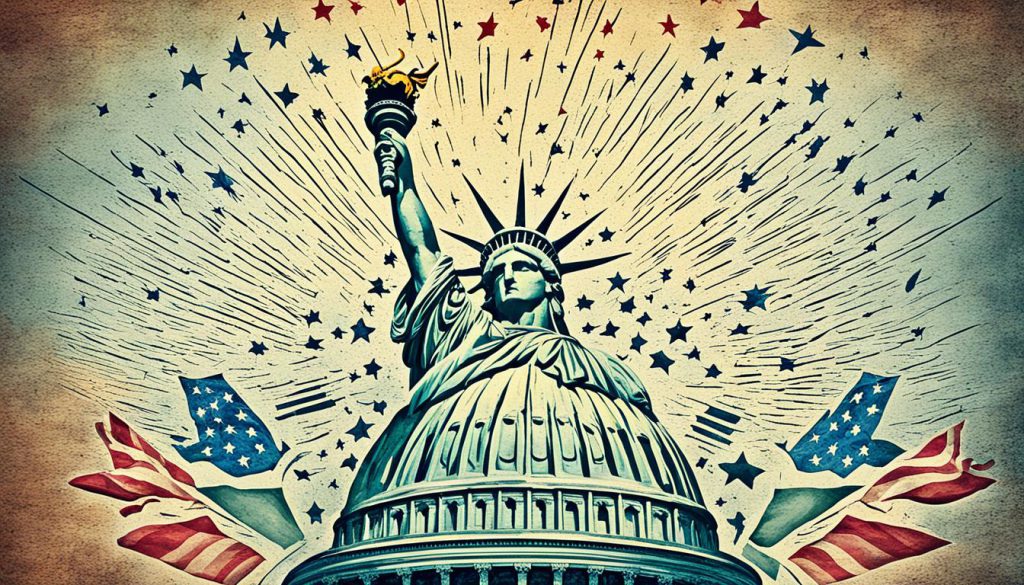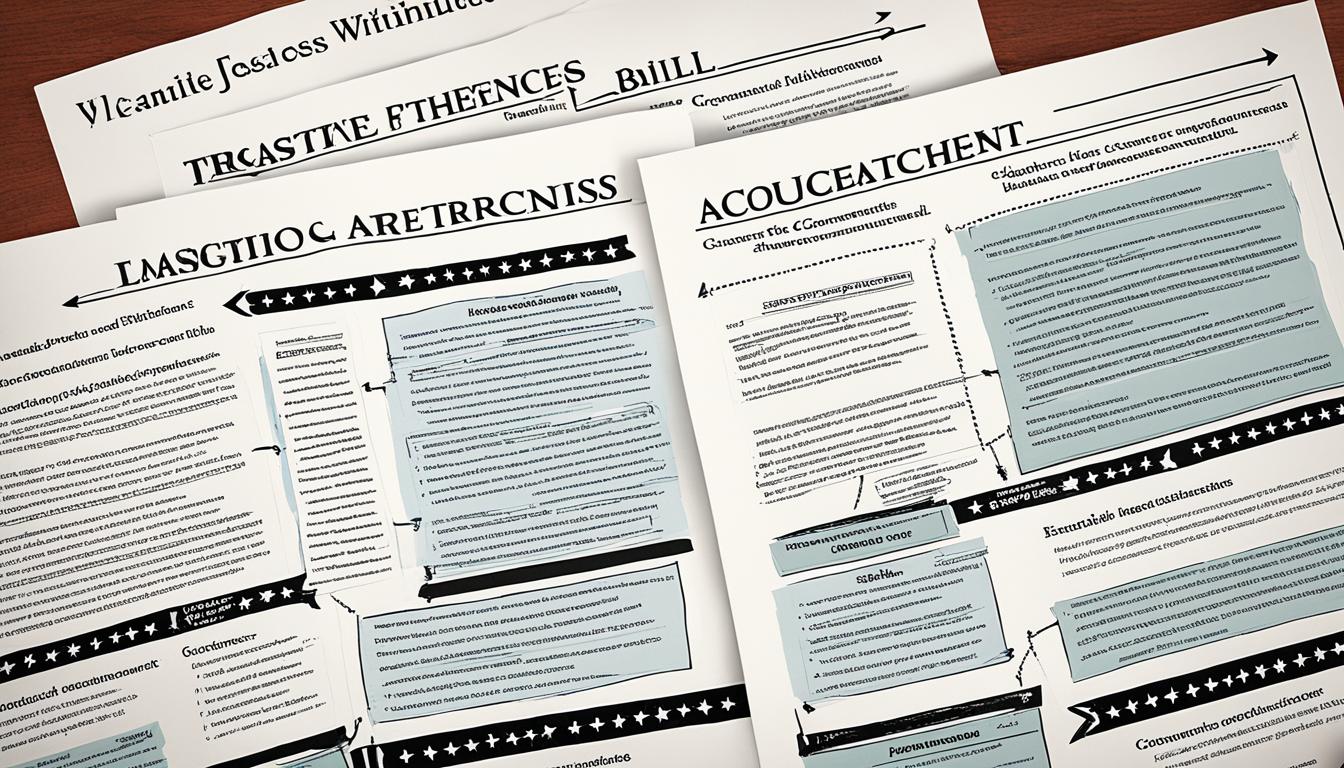Did you know the U.S. has over 20,000 federal laws? These laws range from big policies to minor rules. They play a big role in government policy and affect our everyday lives. Understanding these laws helps us navigate legal matters and take part in democracy.

Key Takeaways:
- U.S. legislation encompasses laws and regulations that shape government policy.
- Understanding the legislative process is essential for navigating the legal landscape.
- The Six Big Ideas in the Constitution provide a foundation for American politics.
- Analyzing primary sources helps connect the Six Big Ideas to historical events.
- Debating the Six Big Ideas in contemporary society influences public policy discussions.
How Are Laws Made?
In the United States, making laws is a key part of our society. It’s how our government works and affects our daily lives.
A representative starts the process by sponsoring a bill. After that, the bill goes to a committee for deep analysis.
The committee stage is essential. Here, members talk about the bill and might make amendments. They debate to make sure the bill will benefit the citizens.
“Committees play a vital role in the legislative process by carefully evaluating bills and shaping them into laws that address the needs of the people.”
If the committee agrees, the bill goes to a voting stage. It needs a simple majority vote in both the House and Senate to pass.
After passing in one chamber, it moves to the other. They must agree on a single version of the bill.
A conference committee fixes any differences. Members from both chambers create a unified version of the bill.
The bill gets final approval in the House and Senate. Then it goes to the President to sign or veto.
This process makes sure laws are carefully checked and represent what the American people need.
Breaking Down the Legislative Process
Let’s go through each stage:
- Bill Sponsorship: A representative introduces a bill.
- Committee Analysis: The bill is analyzed by a committee.
- Amendments and Debates: Changes are suggested, and discussions happen.
- Voting: The bill is voted on in the House and Senate.
- Conference Committee: Differences are resolved to unify the bill.
- Final Approval: The House and Senate give the final vote.
- Presidential Decision: The President either signs or vetoes the bill.
Understanding how laws are made helps us participate in democracy. It lets us shape laws and speak up for important issues.
The Significance of the Six Big Ideas in the Constitution
The Constitution of the United States has Six Big Ideas at its core. These ideas are limited government, republicanism, checks and balances, federalism, separation of powers, and popular sovereignty. They are key to its principles and affect American politics even now.
Limited government means the government’s power is kept in check. This is to stop it from getting too strong and stepping on individual rights. It makes sure the government stays within its limits and respects citizen freedoms.
Republicanism pushes for a government where officials represent the people’s interests. It argues that citizens should have the power, exercised by those they elect.
Checks and balances prevent any government branch from getting too powerful. It sets up a system where the executive, legislative, and judicial branches can limit each other. This system shares power among them.
Federalism is about the national and state governments working together. It gives some powers to the national government while states keep some control. This balance allows states to manage their own affairs within their territories.
Separation of powers spreads out government power to avoid dominance by one party. It parts power among the executive, legislative, and judicial branches. This setup supports checks and balances and ensures no single group gets too strong.
Popular sovereignty means all political power comes from the people. The Constitution gives citizens the authority and power to make decisions through democracy. This lets them show their will by choosing their representatives.

The Constitution’s Six Big Ideas form its core principles and guide the U.S. government’s structure. They reflect the Founding Fathers’ values and aims to create a balanced system. This system protects individual freedoms while ensuring accountable governance.
Mapping the Text of the Constitution
Understanding how the government works, as the Constitution shows, is key to knowing the Six Big Ideas. When students map the Constitution’s text, they look at how much attention each government part gets. This helps see what the Founding Fathers thought was most important.

The Constitution is the base of America’s laws. It shows how the government is structured and what powers it has. Studying the Constitution lets students see how the Founding Fathers wanted the government to work.
When you map the Constitution’s text, you focus on main articles, sections, and changes. This looks at how powers are split between the branches of government. Students also look at checks and balances that keep one branch from getting too powerful.
“We the People of the United States, in order to form a more perfect Union, establish Justice, insure domestic Tranquility, provide for the common defence, promote the general Welfare, and secure the Blessings of Liberty to ourselves and our Posterity, do ordain and establish this Constitution for the United States of America.”
This famous line from the Constitution’s Preamble shows the Founding Fathers’ goals. They wanted a better union and freedom for future generations. The text outlines how the government should be structured and work.
Looking closely at the Constitution’s text helps students understand the Founding Fathers’ plans. They learn about the safeguards put in place and the powers given to each government branch. This understanding is vital for knowing the Six Big Ideas and their importance in the Constitution.
Analyzing Primary Sources to Relate the Six Big Ideas to History
Studying the Six Big Ideas in the Constitution needs a deep dive into primary sources. This helps understand their role in American history. By looking at documents from the federal government, students link these ideas to historical events.
Primary sources show what the Founding Fathers thought and debated. They include the Constitution’s drafts, the Federalist Papers, letters, and other key documents. By looking at these, students see the ideas and reasons behind the Six Big Ideas.
The Founding Fathers wanted a government with limited power. They divided power among branches and levels. This was to keep any one group from getting too strong. The Bill of Rights shows their commitment to individual rights and people’s rule.
Primary sources also give a view of history. For example, they show how federalism worked during the Civil War or the Civil Rights Movement. Students can see how the Six Big Ideas were used or challenged during big changes in society.
Primary sources offer a look into the Founding Fathers’ minds and the time the Constitution was made. They help students appreciate how the Six Big Ideas shape our government and society.
Looking at primary sources builds critical thinking and historical analysis skills. It lets students understand the Six Big Ideas better. They learn the values and principles of the American political system.
Debating the Six Big Ideas in America Today
The Six Big Ideas play a huge role in American debates today. They are at the heart of the U.S. Constitution. They guide current issues and spark discussions on important ideas like limited government and popular sovereignty.
Diverse opinions on the Six Big Ideas lead to many debates. People and leaders think differently about how the government should act. This causes debates on applying these ideas to today’s problems.
Debates about limited government are common. Some people think it protects freedom and lets everyone pursue their goals. Others feel it might miss important regulations and ignore social needs. They suggest a government that steps in more.
Republicanism brings debate too. It’s about finding balance between representing citizens and making decisions efficiently. Issues include how well elected officials reflect the people’s will and the influence of money in politics.
The idea of checks and balances raises discussions as well. Some see it as key to keeping the government in check and protecting rights. But some worry it leads to too much political fighting and manipulation.
Federalism triggers talks about power distribution between the national government and states. Some like it for making policy fit local needs better. But others are concerned about uneven state resources and big issues that cross state lines.
Splits over separation of powers focus on the balance among government branches. Advocates say it prevents any branch from getting too powerful. Critics, though, talk about political fights and accusations that branches overstep their bounds.
Popular sovereignty, or the idea that the people have the final say, stirs debates about democracy. Topics include making sure voting is fair, ensuring everyone is represented, and how much majority rule should influence decisions.
Diving into these debates helps us understand these big ideas better. It leads to better decisions and lets us see different views. These talks are crucial for a healthy democracy and moving forward.
“Debates are the foundation of progress and an essential part of a thriving democracy.” – [Insert Author Name]
Conclusion
Understanding U.S. laws is key for everyone who wants to know how the government works. By learning about the law-making process, people can fully grasp how laws affect our lives and society.
Knowing about the Six Big Ideas in the Constitution helps understand American government basics. Looking at these ideas against both historical events and today’s debates makes them more meaningful.
Becoming well-versed in U.S. laws lets people have a say in government decisions. Staying informed helps everyone make choices that reflect their goals for a better community.
